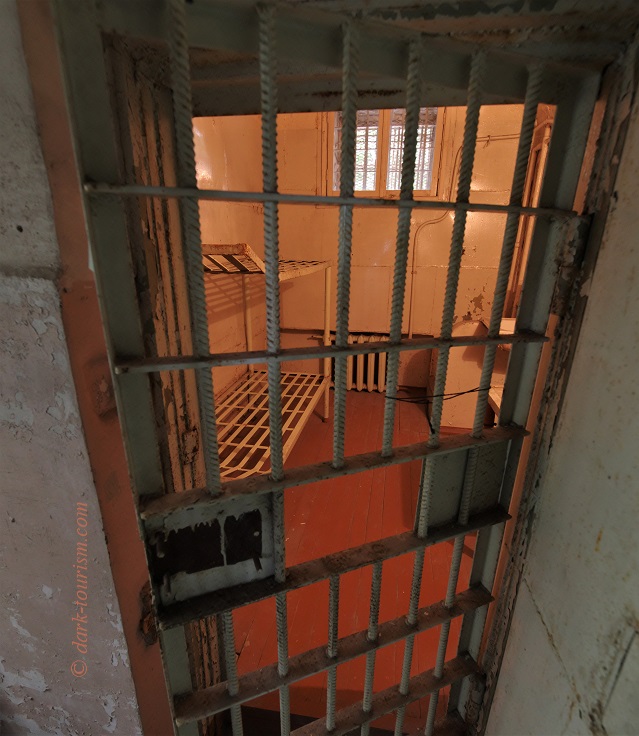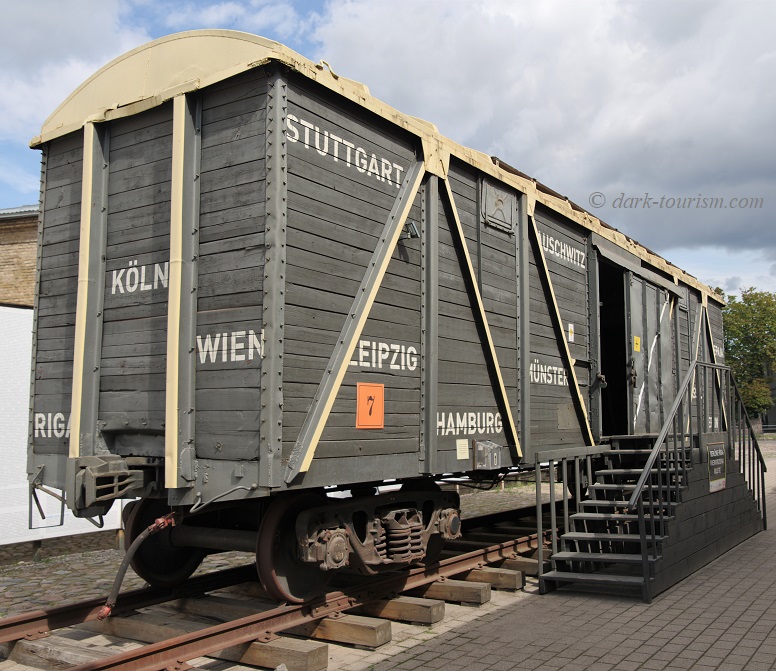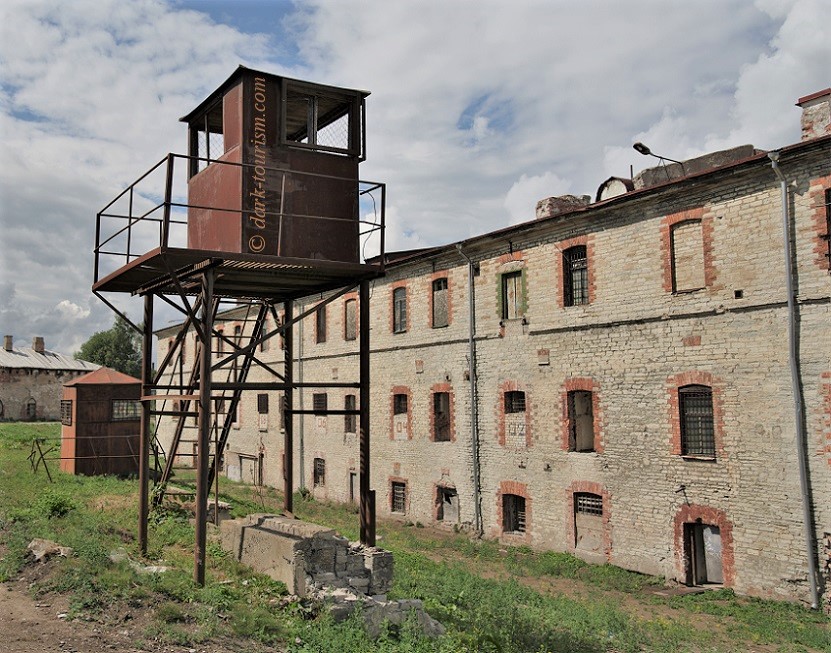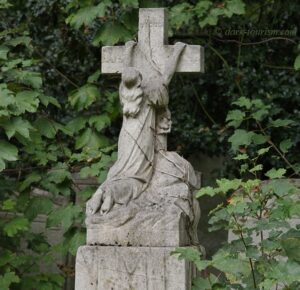Last Wednesday I came back from a nine-day return trip to the Baltics, well, just to two of the capital cities, Riga in Latvia and Tallinn in Estonia. My first trip to the region had been in 2014, and I knew that in these cities a few new sites of relevance to dark tourism had newly opened in the meantime or had changed significantly, thus warranting a re-visit.
In Riga, the main thing was the cell tracts of the “corner house”, which used to be the regional HQ of the KGB. The visit was by guided tour, which had to be pre-booked online, and a valid EU Covid vaccination certificate, current negative test result or proof of recovery had to be presented. This was indeed checked before the start of the tour. In general, Latvia was much stricter in this regard (whereas Estonia was surprisingly lax). The tour lasted a full hour and took our small group of four foreigners plus the guide through the original ground floor and basement prison cell tracts, the prison kitchen and a couple of interrogation rooms. As you could imagine it was all suitably grim. Here’s a photo of one of the corridors with open cell doors:

Having moved on to Tallinn, I first made my way to Maarjamäe on the north-eastern outskirts of the city. There I re-visited the Soviet-era Maarjamäe Monument, which I had already seen as part of the “Soviet Tallinn” Tour I had been on in 2014. It is quite indicative of the general anti-Soviet mindset in Estonia that this monument is clearly not seeing the maintenance it could do with, as it has deteriorated considerably over the past seven years, some particularly crumbling parts of it were even fenced-off and there were “no trespassing” signs. Here’s a current photo:

Just behind this monument lies the symbolic German war cemetery, which I had also already seen in 2014. It was noticeable that this memorial site to the German Wehrmacht “defenders of Estonia” of 1944 (i.e. against the Soviet Red Army in WWII) looks much better maintained than the Soviet victory memorial adjacent to it. Moreover, an all-new shiny monument and memorial park were added in 2018 – this commemorates the Estonian victims of communism. The next photo shows the main black marble part of this new monument in the background, while in the foreground you see a part of the German “defenders of Estonia” memorial complex:

This time I also visited the Maarjamäe Palace and the contemporary history exhibition inside. It’s about Estonian history from ca. 1917 to the present day and is tellingly entitled “My Free Country” now. As you would expect from this title – and from the generally prevalent anti-Soviet mindset of most Estonians – the emphasis is on independence and its suppression during the era of occupation by the Soviet Union. However, it wasn’t all totally anti-Soviet. Some improvements of life and achievements made in this period were acknowledged too. What I was enlightened about especially in this exhibition, something I hadn’t been so aware of before, was the so-called “Phosphorite War”, an environmental protest movement that fought against the destructive and polluting mining operations of that mineral during the late Soviet era and how that movement paved the way for the new fight for independence, which was achieved in 1991. The latter is naturally also a major focus in the exhibition.
All this contrasts with a perhaps unexpected hidden gem in the backyard behind the museum. When I had visited this place in 2014 (when the museum was closed) our guide took us to this very plot where we saw a jumble of old communist-era statues and busts, mostly toppled and just dumped here. But I already knew from looking at newer photos on Google Maps that this had changed. Now the statues have been re-erected and come with plaques explaining their origin, former locations and who is depicted. In the case of the various Lenins, this is hardly necessary, nor for the sole surviving Stalin statue, which had been stored here since the early 1960s. But less well known figures do indeed need some explanations. So this is a welcome new commodification about the communist era. Here’s a new photo of part of the re-erected communists:

I then took a bus all the way to Viimsi to the north of Tallinn to visit the Estonian War Museum. This turned out to be a much more old-school affair than the Maarjamäe museum. It covered some older history, WW1, Estonia’s War of Independence, WWII, the Cold War and Estonia’s new-found role within NATO. Displays included weapons, uniforms, medals and all that sort of stuff as well as a few life-size dioramas with dummies in uniforms. Most intriguing and revealing I found an arrangement of three dummies, two Estonians and one German Wehrmacht soldier having drinks together – to me it seemed to say: oh those happy days when it wasn’t the Soviets but “only” Nazi Germany that occupied Estonia! Here’s a not exactly perfect photo of this diorama. Please excuse all those reflections on the glass, but I wasn’t able to capture the whole scene when placing my lens directly on the glass to avoid the reflections but had to step a bit further away to get all three figures in the frame:

The next day my first port of call was the Tallinn equivalent of the Riga KGB House (see above). The house as such has been converted into flats, but the cellar with the old KGB cells has been opened to the public in recent years by the Estonian Museum of Occupations. When I was there in 2014 there had been no indication of what this location used to be and without our guide I wouldn’t have had any idea. Now there is a small exhibition in parts of the basement that you can explore independently. It only took about 10 to15 minutes. The grimmest part was possibly this wardrobe-like “standing cell” (used for punishment or prior to interrogation):

My main reason for revisiting Tallinn, however, was Patarei Prison. Just before the first lockdown I had actually been contacted by someone from the site’s management informing me that the new museum part inside the ex-prison was about to open, and so I had planned a short trip to Tallinn for a long weekend in May 2020 – but this, like all my original travel plans for that year, then fell victim to the pandemic and had to be cancelled. But now I’ve seen Patarei Prison and can report some impressions and provide a few photos. This first one (same as the featured photo at the top of this post) shows a watchtower and the central part of the complex:

The museum is housed in only a part of the south-eastern wing of the main building while the rest is currently either derelict or used for other purposes. There was a poster that outlined visions for the future of the complex that to me seemed rather depressing: apparently there are plans to convert the whole complex into yet another gleaming shopping and entertainment centre and going by the “artist’s impression” on the poster the conversion would leave next to nothing of the original building visible. What this will mean for the current museum is also not quite clear. I know that a grand modernization and expansion is scheduled to be completed by 2025, but how much of the original structures will be retained is not at all clear. For now the exhibition inside is a temporary stand-in commodification only. But its main drift is very clear and just what you’d expect from such a place in Estonia, and this is made clear right at the entrance:

At least they get the grammar right here – whereas on the museum’s website it still says “communism is prison”. Inside the building are numerous text and photo panels that underscore this general drift and also provide plenty of personal stories of individual victims of the communist era, especially in the years before Stalin’s death in 1953. The main aspect for me, however, was the dank corridors and the cells, which were at times a photographic challenge. Here’s just one example of the almost 200 photos I took at Patarei:

At the end of the circuit a replica Lenin head can be seen toppled into the dust accompanied by a well-known sentiment in dark memorial museums:

The optimistic outlook that remembrance prevents repeated atrocities, a version of the old line “those who don’t learn from their history are condemned to repeat it” or the usual “never again” at Holocaust museums, is unfortunately not borne out by the most recent history since 1991 with its countless conflicts and atrocities in so many parts of the world …
The next day required another long bus ride out of the city as such, this time to the TV tower, or “Teletorn” in Estonian, in the suburb of Pirita:

The tower is also a somewhat darkish site insofar as, on the one hand, it was constructed during the Soviet era, and as such, like so many such towers all over the former Eastern Bloc, served not only its technical purpose but also as a symbol of Soviet progress and achievements. On the other hand, it was also a location of significance during the dramatic August of 1991 when Soviet troops, in the wake of the attempted military putsch in Moscow, also came to Tallinn and threatened to turn back the clock, just after Estonia had declared its independence. Crowds of Estonians came to the base of the tower to defend it and the plucky technicians in the operation rooms at the top blocked the lift doors (allegedly with just a matchbox) so the soldiers could only have ascended the tower through the staircase with its over a thousand steps. The defenders also threatened to use the oxygen-extraction mechanism (a fire-fighting measure) had the troops attempted the ascent. And thus the vital radio communications were not cut off. Eventually the military left the tower and Estonia as the Moscow putsch collapsed. Hence the “Teletorn” is seen in Estonia as an important symbol of gaining independence from the USSR. Since 2012 visitors have been able again to take a lift to the tower’s viewing deck 175m above ground, see a couple of exhibitions, and have a drink and/or meal in its restaurant.
For the rest of my stay in Tallinn, dark tourism took a back seat for once and instead was replaced with exploring some revitalized former industrial quarters, visiting some art galleries and otherwise just enjoying the magnificent Old Town of Tallinn with its many intact mediaeval features, including large parts of the city walls and its towers:

After Tallinn I got a bus back to Riga, stayed one more night there and the next day had several hours at my disposal before the flight back to Vienna. So I added some more exploring, in particular a re-visit to the Riga Ghetto Museum, since I had seen from the bus that a new large exhibit had been added, namely this railway car; painted on it are the names of various places of origin as well as destinations of the deportations during the Holocaust:

And while there I also discovered that several new indoor exhibitions have been added to the formerly 95% open-air museum; parts of these were contributed by the Žanis Lipke Museum. So another significant change, and definitely an improvement.
In the Old Town of Riga I also noticed that the former and again future location of the Museum of the Occupation of Latvia, currently housed at a temporary location, is nearing completion. On the first day of this 2021 trip to Riga I still saw a construction site fence around the base, but on my return to Riga a week later this had disappeared. Inside there was clearly still some work going on, but I would guess the main structural work, including an annexe to the original Soviet-era edifice, should soon be ready for the moving back of the permanent exhibition here. This was originally scheduled already for 2020, but I guess pandemic-related conditions caused the delay. Here’s a new photo of that museum building:

And finally, what I had already noticed on landing in Riga on the first day of this trip I also saw again from the plane as we taxied for take-off for our return flight to Vienna: the historic Tupolev Tu-22M supersonic bomber plane that used to be parked right next to the Riga Aviation Museum has been moved to a location to the side of the airport runway, so you can now only see it when using the airport, but no longer from close up:

The Aviation Museum as such, however, seemed to be still in place, as I could also see from the plane, with the giant Mil-Mi-6 helicopter still dominating the collection. On its website, however, it currently says “The museum temporary closed” (sic!). I hope that is only because of the pandemic and that it will reopen before too long.
Speaking of long, this post has become really long enough, so I will leave it at this. I hope readers will enjoy this first fresh-from-new-travels report and photos since I went to Switzerland about a year ago. And now I have to get ready for the next trip, which will start on Thursday 12 August and will take me to Poland and Germany. At least travel within the EU is currently still possible. When I can go back to my plans for travelling further afield, in particular to Taiwan and Namibia, remains to be seen … Hopefully next year will be better, pandemic-wise.





2 responses
I have seen similar prisons in Ukraine
How can human beings treat human beings so horrifically ?
The present appeasement policies of the Western and Europen leaders towards putin will reopen these prisons in the future. Destabilisation of Latvia and Lithuania by Beloruss and russia by impregnating immigrants into those nations is but one step towards destabilisation.
I’ve been thinking long and hard whether to approve this comment, because I don’t want this DT blog (about dark history) to be used as a platform for controversial current affairs/politics discussions. But I’m intrigued about those “similar prisons in Ukraine” that you mention. Do you mean similar to Patarei? That is: open to and commodified for (international) visitors? If so, could you be more specific (names, locations) please? As for the rest: unfortunately such treatment of humans by humans is a thread that goes through all of history. Whether “appeasement” is the most fitting word regarding the West’s attitudes towards Russia I’m not so sure. Nor do I think it’s likely that former prisons, once they’ve become tourist sites, would really ever return to serving their previous functions. What’s currently happening in Belarus and its border with the Baltics is indeed disturbing, though it’s hardly the immigrants’ fault. But back to being on this blog’s topic: please provide more info about those ex-prisons like Patarei in Ukraine that you indicated. That could be quite valuable information to me and this blog’s readership.